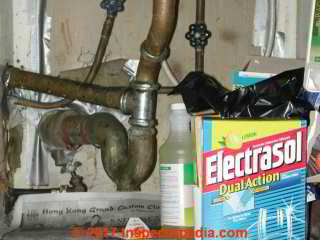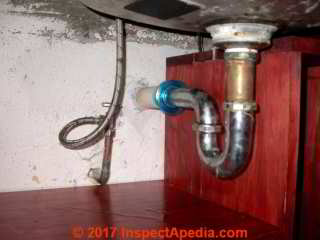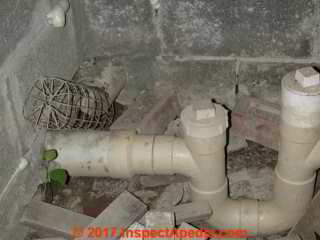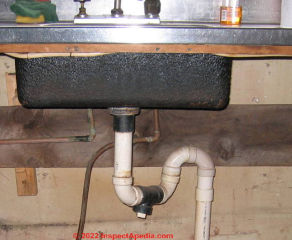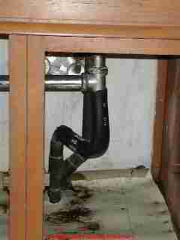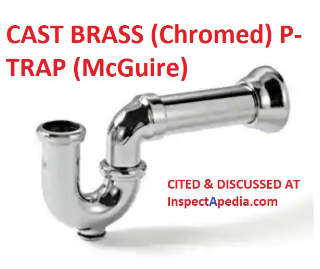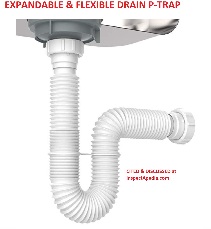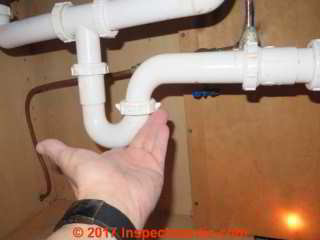 Plumbing Interceptor / Trap Materials
Plumbing Interceptor / Trap Materials
Plastic, metal plumbing traps & interceptors: types, properties
- POST a QUESTION or COMMENT about plumbing traps or plumbing interceptors
Plumbing drain trap or interceptor materials of construction:
This article describes the different materials from which plumbing traps (also called plumbing interceptors) are made, such as plastic, brass, cast iron, and we discuss the different properties of each of these plumbing trap materials.
This plumbing traps (interceptors) article series describes plumbing traps (interceptors) and how to diagnose, find, and cure odors in buildings including septic or sewage or sewer gas smells or "gas odors" in buildings with a focus on homes with a private onsite septic tank but including tips for owners whose home is connected to a sewer system as well.
InspectAPedia tolerates no conflicts of interest. We have no relationship with advertisers, products, or services discussed at this website.
- Daniel Friedman, Publisher/Editor/Author - See WHO ARE WE?
Plumbing Trap Materials: Metal vs PVC Plumbing Traps & Interceptors
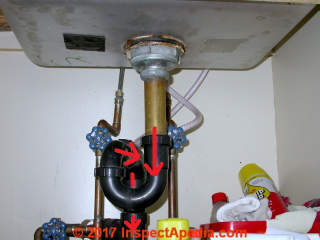 Plumbing traps are constructed of any of a number of old traditional materials, principally metals, occasionally wood, or of newer plastic materials.
Plumbing traps are constructed of any of a number of old traditional materials, principally metals, occasionally wood, or of newer plastic materials.
[Click to enlarge any image]
This photo series will permit you to identify the type of plumbing trap or interceptor material at an installation.
Here we also discuss the leak risks that differ depending on the plumbing interceptor or trap type and material that was used.
Keep in mind that when replacing a plumbing interceptor or plumbing trap, you can usually opt for a material of your choice.
Just be sure that you match the proper size and fittings of the old trap when buying a replacement plumbing trap.
[Click to enlarge any image]
ABS plastic (black plastic) plumbing traps - durable, widespread, 1975-present, shown above.
Brass plumbing traps / interceptors - traditional, widespread use 1900-present, including thicker-walled cast brass (above and in real trouble) or thin-walled brass, possibly chrome plated that we'll show below.
You might note that most of the plumbing interceptors we show here are suffering in some way, askew, broken, loose, corroded, leaky.
Note:
At InspectApedia many or our building component photographs were originally taken to document real-world, in-service conditions that are found by trades people, plumbers, for example, or by building inspectors, contractors, home inspectors, or chartered surveyors. These images show conditions rather than showcasing products even when the products are ones we love.
Cast iron plumbing traps (shown above) are more-likely to be found as the house trap or main building drain trap at point at which the sewer piping exits from a building.
You'll recognize cast iron drain/waste/vent piping (DWV) by the thick heavy pipe edges at the pipe hubs and cleanouts [click to enlarge the image] and you can confirm the use of cast iron with a magnet - which will adhere to the pipe surface.
Chrome-plated brass plumbing traps / interceptors - traditional, widespread use world-wide, 1960's - present. Shown above, a leaky chrome-plated brass thin-walled plumbing trap below the author's sink in Mexico. This trap appeared to be leaking but the water was actually from a corroded leaky sink strainer assembly above the trap itself.
[Image needed: galvanized iron plumbing trap] Use the page top or bottom CONTACT link to send us photos for comment or contribution.
Galvanized iron plumbing traps, traditional, 1920 - 1970
Plastic or PVC plumbing traps - widespread, world-wide, 1977 - present. Some plastic plumbing traps are also silver coloured and may be chrome plated. Shown above, first photo: a PVC building sewer line trap providing drain cleanout openings at the foundation wall of a U.S. home. Second photo, a typical white plastic PVC plumbing interceptor or drain trap below a kitchen sink. I'm feeling for wet spots or leaks after having installed new parts.
Below is a photo of a do-it-yourself home-made plumbing interceptor made out of PVC plumbing parts. This trap may not work properly as its dimensions are "non-standard" and also because it's not a P-trap - there is no connection to a plumbing vent.
We discuss this cute home made plumbing trap again at PLUMBING TRAP LEAKS & MISSING INTERCEPTORS.
Below is another home-made or "expedient" plumbing trap that is not a trap.
Rubber plumbing traps (shown above made of an automotive radiator hose) found on some home-made systems didn't work, but rubber traps might be used successfully in other forms. This one, providing no trap, allows sewer gases right up into the building. And it leaks too.
Stainless steel plumbing traps, and nickel plated plumbing traps offer extra corrosion resistance. Some of these are nickel-plated such as the bottle trap ( a small drum trap) I'm holding in the photo above.
Details about where leaks occur on plumbing traps of all types are at PLUMBING TRAP LEAK POINTS.
...
Reader Comments, Questions & Answers About The Article Above
Below you will find questions and answers previously posted on this page at its page bottom reader comment box.
Reader Q&A - also see RECOMMENDED ARTICLES & FAQs
Question: what material should we choose when replacing a leaky plumbing trap
 We are in a condo building that is four years old. All of our p-traps are chrome plated.
We are in a condo building that is four years old. All of our p-traps are chrome plated.
One of them has already developed a hole in it and caused a leak, damaging our cabinet despite catching it early. We checked the others in our unit and they all show signs of corrosion ...leading us to worry that they will also leak very soon.
Can you please advise on the preferred suggested material for us to replace ours with? The condo board says it is up to us and we want a worry-free situation.
Plumbing supply places are reluctant to advise when it comes to condo buildings so we would appreciate your expertise and guidance. Thanks so much. - Anonymous by private email 2019/08/23
Reply:
You can use new heavier gauge chrome plated brass OR if you like, switch to white PVC plumbing traps. Just measure the trap diameter to be sure you're buying the right replacement - typically 1 1/2" or 1 1/4" diameter.
Plastic P-trap nuts should be tightened only by hand to avoid breaking the joint.
Watch out: don't be fooled: any plumbing trap can leak.
A metal plumbing trap may corrode-through and leak, usually first as a drip later as a worse leak. It may also leak if the trap connectors are not properly tightened or if the internal gaskets or washers are omitted at the connectors.
Examples of heavier duty (thicker 17-gauge) chrome plated metal P-traps:
- Lasco produces a heavy-duty 17-gauge "Plumbers Grade" P-trap in chrome plated brass.
Remember: when considering metal "gauge", the smaller the number, the thicker the metal. So a No. 17-gauge metal P-trap is thicker or heavier-duty than a #22-gauge metal P-trap. - McGuire Manufacturing produces a chrome plated cast-brass heavy-duty P-trap - shown above - with a 17-gauge sweat extension and a chrome plated steel deep bell flange for use at the wall penetration. Cast brass will be the thickest, heaviest metal trap you might install.
A plastic plumbing trap won't corrode through but it can leak from being over-tightened, especially where lower-quality PVC trap parts are used; Over-tightening leads to snapping a connector ring nut or there can be leaks from being under-tightened too - a problem with any mechanically-attached plumbing trap.
The white plastic plumbing trap shown above on this page is PVC and works just fine. But there's a heaver-duty option too:
- Heavier, thicker ABS (black plastic) P-traps and drain piping are available but might not be compatible with the existing plumbing in your building (that may be metal).
NIBCO produces an ABS P-Trap (shown above) as do other manufacturers.
The advantage of this ABS P-trap is that except by exceptional mechanical damage that cracks the fitting, it's nearly indestructible.
A disadvantage of this ABS P-trap is that if it's glued in place and needed to be replaced (for example because some fool stripped the cleanout nut) your plumber will have to cut it out to re-glue new fittings in place.
In my OPINION I would avoid thin-wall plumbing traps of any material and I would avoid those flexible "accordion" traps (shown below) that seem easier to install and use fewer parts (a plus) but may not flow as well and may be more clog-prone than a smooth-surfaced plumbing drain line and P-trap.
...
Continue reading at PLUMBING S-TRAP CODES & HAZARDS or select a topic from the closely-related articles below, or see the complete ARTICLE INDEX.
Or see PLUMBING TRAP, INTERCEPTOR FAQs - questions, answers, comments posted originally at this article
Or see these
Recommended Articles
- PLUMBING TRAPS & INTERCEPTORS - home
- CLOGGED PLUMBING TRAP CAUSE & CURE
- DEFINITION: PLUMBING TRAPS & PLUMBING INTERCEPTORS
- DRY PLUMBING TRAP CAUSE & PREVENTION
- GREASE INTERCEPTORS TRAPS
- LOOSE TOILETS LEAK SEWER ODORS
- PLUMBING S-TRAP CODES & HAZARDS
- PLUMBING TRAP HISTORY
- PLUMBING TRAPS, ILLEGAL
- PLUMBING TRAP LEAKS & MISSING INTERCEPTORS
- PLUMBING TRAP LEAK POINTS
- PLUMBING TRAP MATERIALS & PROPERTIES
- SEWER GASES vs PLUMBING TRAPS & VENTS
Suggested citation for this web page
PLUMBING TRAP MATERIALS & PROPERTIES at InspectApedia.com - online encyclopedia of building & environmental inspection, testing, diagnosis, repair, & problem prevention advice.
Or see this
INDEX to RELATED ARTICLES: ARTICLE INDEX to PLUMBING SYSTEMS
Or use the SEARCH BOX found below to Ask a Question or Search InspectApedia
Ask a Question or Search InspectApedia
Try the search box just below, or if you prefer, post a question or comment in the Comments box below and we will respond promptly.
Search the InspectApedia website
Note: appearance of your Comment below may be delayed: if your comment contains an image, photograph, web link, or text that looks to the software as if it might be a web link, your posting will appear after it has been approved by a moderator. Apologies for the delay.
Only one image can be added per comment but you can post as many comments, and therefore images, as you like.
You will not receive a notification when a response to your question has been posted.
Please bookmark this page to make it easy for you to check back for our response.
Comments
IF above you see "Comment Form is loading comments..." then COMMENT BOX - countable.ca / bawkbox.com IS NOT WORKING.
In any case you are welcome to send an email directly to us at InspectApedia.com at editor@inspectApedia.com
We'll reply to you directly. Please help us help you by noting, in your email, the URL of the InspectApedia page where you wanted to comment.
Citations & References
In addition to any citations in the article above, a full list is available on request.
- "Guidance Document for Sizing and Installation of Grease Traps and Interceptors", Carrolton Texas, January 2012, retrieved 2/16/2014, original source: http://cityofcarrollton.com/Modules/ShowDocument.aspx?documentid=8181
- Kia Gregory, "New York Tries to Clear Its Sewers of FOG (Fat, Oil, and Grease)", The New York Times, p. A18, 15 February 2014
- Thanks to Slade Franklin for the reminder that a leaky wax ring at a toilet can lead to septic odors in bathrooms. 11/2007
- Thanks to J.V. (privacy protected) for the reminder to make a detailed inspection of the plumbing vent system when sewer gas odors are present. 07/2008
- Thanks to Roger Hankey & Cheryll Brown, www.hankeyandbrown.com, ASHI home inspectors in Minnesota, for the deteriorated transite pipe gas flue vent photograph and comments. Mr. Hankey is a past chairman of the ASHI Technical Committee, serves as co-chairman of ASHI legislative committee, and has served in other ASHI professional and leadership roles. 7/2007.
- Thanks to Alan Carson and Bob Dunlop, Carson Dunlop, Associates, Toronto, for permission to use illustrations from their publication, The Illustrated Home which illustrates construction details and building components. Carson Dunlop provides home inspection education, publications, report writing materials, and home inspection services. Alan Carson is a past president of ASHI, the American Society of Home Inspectors.
- Steve Smallman, Raleigh, NC, Email: steve@stevesmallman.com, Website: http://stevesmallman.com/ - Quoting: Steve Smallman Property Inspections (SSPI) inspectors have performed or supervised over 25,000 inspections since we introduced home inspections to the Triangle area in 1980. Mr. Smallman is a contributor to InspectApedia.com and has commented on or provided information on plumbing traps, commercial FPE electrical panels and DIY Tests of FPE equipment,, roofing underlayment, and building exteriors.
- Our recommended books about building & mechanical systems design, inspection, problem diagnosis, and repair, and about indoor environment and IAQ testing, diagnosis, and cleanup are at the InspectAPedia Bookstore. Also see our Book Reviews - InspectAPedia.
- In addition to citations & references found in this article, see the research citations given at the end of the related articles found at our suggested
CONTINUE READING or RECOMMENDED ARTICLES.
- Carson, Dunlop & Associates Ltd., 120 Carlton Street Suite 407, Toronto ON M5A 4K2. Tel: (416) 964-9415 1-800-268-7070 Email: info@carsondunlop.com. Alan Carson is a past president of ASHI, the American Society of Home Inspectors.
Thanks to Alan Carson and Bob Dunlop, for permission for InspectAPedia to use text excerpts from The HOME REFERENCE BOOK - the Encyclopedia of Homes and to use illustrations from The ILLUSTRATED HOME .
Carson Dunlop Associates provides extensive home inspection education and report writing material. In gratitude we provide links to tsome Carson Dunlop Associates products and services.


